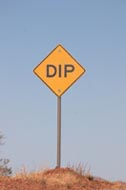
|

|
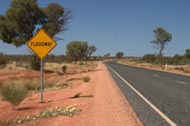
|
There are dips in every country, but Australia takes them seriously. Actually, we have no idea why some dips are highlighted with a sign, while others are left for you to find at high speed, and still others are marked with the third sign on this row.
|
In the U.S., we call this either a "cattle gate" or a "stock gate". Apparently, Australia is part of "The Grid".
|
Gotta like this one: "floodway". (Spelled backwards, that is "yawdoolf"... You work out a lot of things driving 5000 kilometers...) The translation of floodway is a low spot in the road (but not a "dip", apparently) where water rushes across when it rains a lot. A later page will show some of these in action...
|
|
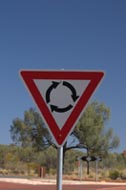
|
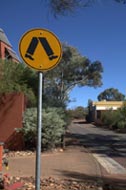
|
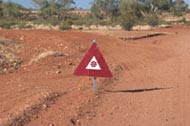
|
"Yield to recycling."
|
"Disembodied legs found here."
|
"Asterisks ahead."
(This one is kinda subtle out of context and just represents a warning. Even in context it could be subtle, since it would appear along the side of a gravel road, where the edge had been a drop-off into loose sand for the last several kilometers, leaving an attentive driver to wonder why here warranted particular caution.)
|
|
|
|
|
|
"Bantam weight champion ahead."
|
|
All Australian trains are coal-fired steam engines. Really. That is what this sign is trying to say.
|
|
|
|
|
|
|
|
Yes, we had to stop in the middle of the night to take this picture. Fortunately, most trucks of this size do not drive the dirt tracks at night. Only the Mawlers are that crazy.
|
|
And, yes there are trucks ("Road Trains") that long. We passed a four trailer petrol tanker and took a neat series of pictures during the process. That will appear somewhere later. (And, rest assured that the series was taken by the passenger, not the driver.)
|
|
|
|
|
|
|
|
Apparently, Australians have found it necessary to remind folks just how to drive in their country.
|
|
Note that they also felt it necessary to add the "In Australia" disclaimer or risk a world-wide calamity of people switching sides of the road based on a directive found in the far Outback...
|
|
|
|
|
|
|
|
This sign always appears as a pair, as far as we can tell. Perhaps that means that bicyclists are no higher on the food chain than lizards...
|
|
A closer look at the lizard on this sign seems to reveal a different meaning:
"Watch for wildlife that is already flattened out on the road".
|
|
|
|
|
|
|
|
When heading off into the Outback, you will be greeted with signs indicating road status along the "track". This is the sign for the Strzelecki Track, which we did not take. It crosses the formidable Strzelecki Desert. And, still, we have no idea how to pronounce it.
|
|
Two fun parts of this sign, which are easier to see in detail, are 1) that "severe penalties apply" for driving on roads that are closed (we suppose they mean above and beyond getting stuck and/or perishing in or near your vehicle) and 2) that the track to Mt. Hopeless is "open".
|
|
|
|
|
|
|
|
Australians are serious about informing you of the dangers of gravel roads. This is just one sign that appears with others at various intervals all along gravel roads. Funny thing is, by the time you get to this sign, you are already on the gravel road and probably well aware of it, based on the fact that any loose fillings have fallen out of your head because of the bone-shaking washboard surface of the road.
|
|
Also, according to the sign, gravel roads are good for driving on two wheels.
|
|
|
|
|
|
|
|
Another one of the several signs that warn drivers of the danger of gravel roads. Look closely at the surface of the road... Do you see any gravel? It just looked like packed dirt and sand to us.
|
|
A close-up of the sign, so you can read it: "Careful Driving Techniques Are Advised".
On non-gravel roads, please use reckless driving techniques.
|
|
|
|
|
|
|
|
This is yet another sign that generally appears in a group regarding gravel roads. (That makes three, so far.)
|
|
This close-up reveals that it is really a list of items you can expect to find on the road:
- Loose Surface
- Dust
- Corrugations
If you look back to the left picture, the distinct stripes across the road are the corrugations. You can take one of two approaches to the corrugations:
Hit them hard enough that you bounce across the tops of each bump. The risk here is that you will skip right off the side of the road and/or all the loose parts of your vehicle will shake right off, like the passenger.
or
Drive slow enough that you feel like you are driving through a storage yard for railroad ties. This was our approach. Our top speed at one point was about 15mph / 20kmph.
|
|
|
|

|

|
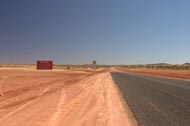
|
Ok, this is the last series of gravel road signs, we swear.
This is a detail of the largest sign, stating,
"Sand drifts and corrugations.
4 x 4 wheel drive advisable.
Access to Kings Canyon via
Lasseter Highway and
Luritja Road is recommended."
It does not take an English degree to read between these lines: "please go another way".
|
And if the tone and message of the big red sign were not enough, they kindly added two other signs we have seen before.
|
Here is the whole context. In this case, the signs are helpfully placed right before the pavement runs out. A few kilometers down this road, it is very difficult to tell where the road ends and the desert begins. The shoulder you can see in this picture is just packed sand. Watch that last step...
|
|
|
|
|
|
Speaking of watching that last step, we spent some time in the opal mining capital of the world: Coober Pedy. Besides opals, the place mostly offers holes in the ground (mines). They are everywhere.
|
|
The mine shafts are so prevalent, that the signs remind you not to run, that shafts are deep, and not to walk backwards.
|
|
|
|
|
|
|
|
And, in case you forgot, mining is serious business.
|
|
This sign reminds you (again) that you could fall into a mine shaft and die. Just as important as falling to your death, however, is that you could be trespassing on a claim. If you don't die, they will fine you $1000.00(AUD).
|
|
|
|
|
|
|
|
Pretty self-explanatory sign, really.
|
|
It can be a long way between mine shafts, so you have to get those machines there somehow and, frankly, there is only one road...
|
|
|
|
|
|
|
|
Despite all the other safety signs, you can probably always use one more.
And this is the best one, by far.
|
|
"Danger, Deep Shafts"
Check out the falling figure's hands...
|
|
|
|
|
|
|
|
If you make it past the mining machines on the road, you just end up with animals on the road.
|
|
Note, these animals not necessarily to scale.
|
|
|
|
|
|
|
|
Just a little scene from the outback: you come around a dirt corner to see a full-fledged highway route sign.
|
|
We actually took the left toward Glen Helen and stopped briefly at side road toward Gosse Bluff which says "4WD ONLY". It was late and our tyres were not really up to a true four-wheel drive route...
|
|
|
|
|
|
|
|
This is the first route sign south of Alice Springs, on the way back to Adelaide.
|
|
It is not all that often you get a distance marking in the four-digit range (even when using kilometers).
Another interesting thing is the parenthetical distance markings... Those are destinations not actually on this road, but accessible from this road. Pretty useful, but not necessarily obvious unless you know the other destinations. That knowledge is much more difficult way off the beaten path.
|
|
|
|
|
|
|
|
Great sign...
|
|
i am feeling pretty good, but was still only 39 on this trip, thanks very much.
|
|
|
|
|
|
|
|
you lookin' for someone?
|
|
Yup, you heard it here first, Stuarts Well Roadhouse is "The Home of Dinky the Singing Dingo".
|
|
|
|
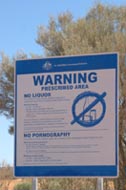
|
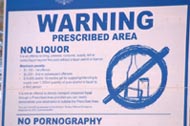
|
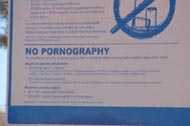
|
As a public service to many of you planning travels in Australia, we post this sign.
When entering Aboriginal lands, there are some restrictions one must follow...
|
No Liquor.
Unless it is unopened and you don't plan to stay in the Aboriginal lands.
|
No Pornography.
Unlike liquor, you can neither possess nor transport, regardless of your destination. Clearly porn is more dangerous than liquor.
Sorry to cramp your style...
|
|
|
|
|
|
If you drive about 30km north of Alice Springs, you come to an easily missed roadside turnout with a small brown sign...
|
|
Yup, the Tropic of Capricorn. Just under the brown road sign, you can see a sculpture which marks the actual latitude. That is our rental parked next to it. Strangely, ours was the only car...
|
|
|
|
|
|
|
|
The farther off the main road you get, the harder it is to find "traditional" unleaded petrol. Instead, they use something called "opal fuel".
|
|
We are fairly certain they get the same question over and over, so they just put up the sign in this detail: "opal is unleaded fuel" (just fill up and quit asking already).
|
|
|
|
|
|
|
|
Another instance of opal fuel. This one provides more explanation right on the pump.
|
|
According to the sticker, opal is "a low aromatic fuel". We asked some folks later who told us that it is not as good as regular gas for getting high. She further elaborated that they need it because of the Aboriginies. Good to know white people never use inhalants to get high...
In case you think we might be making this up, you can read about opal fuel on the world's primary souce, Wikipedia or in this honours thesis, which was linked from Wikipedia, or in the manufacturer's site (BP Australia).
A less dangerous fuel seems like a good idea, so we were left wondering why it would only be useful for the Aboriginies...
|
|
|
|
This last series is just a set of random signs that seemed amusing.
|
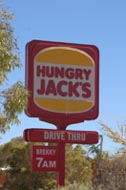
|

|
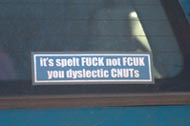
|
Yes, that would be the Aussie "Burger King". Note the Aussification of "breakfast" on the sign.
|
You can choose to be indecisive in either location, here or at the register.
|
Self-explanatory and brilliant.
|
|
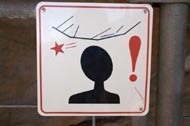
|

|

|
"Watch your head!" Another brilliant rendering of caution into an international sign.
|
A traditional Aboriginal food source is the grub, which is not generic for food. As far as we know, The Grub Shack does not actually serve grubs.
|
One of our personal favorites from Erlunda Roadhouse at the junction of the Stuart and Lasseter Highways. It really speaks for itself, doesn't it?
|
|

